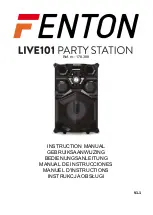
A-30
A.9 INEFFICIENZA
DEI
DISPOSITIVI DI
SICUREZZA
La manomissione degli organi di
sicurezza può causare eccessivi
sovraccarichi alla gru, perdita di
stabilità, urti, caduta del carico,
scollegamento improvviso degli organi
di presa e di sfili manuali, incidenti
durante la circolazione del veicolo,
ecc.
La chiusura non perfetta della gru in
posizione di trasporto può causare
seri danni durante la circolazione del
veicolo: vi è la possibilità di urti
rovinosi delle parti sporgenti contro
oggetti in moto relativo (ponti, garage,
autoveicoli, ecc.).
La mancanza di etichette adesive di
avvertimento può indurre l’operatore a
non prendere in considerazione
pericoli legati al normale utilizzo della
gru.
AVVERTENZE
- L’operatore non deve mai e per
nessun motivo rimuovere, modificare
o disinserire i dispositivi di sicurezza,
siano essi meccanici (protezioni,
blocchi, ecc.), sia elettroidraulici
(valvole, limitatori, sigillatura
impianto), pena la decadenza di ogni
forma di garanzia.
- Nel caso in cui l’operatore voglia
scollegare organi di presa o prolunghe
manuali deve assicurarsi che questi
appoggino su un supporto adeguato
al peso e alle dimensioni e che non vi
sia alcun carico appeso.
- L’operatore non deve togliere, rendere
illeggibili le etichette di avvertimento.
A tal fine non deve indirizzare getti
d’acqua o vapore in pressione contro
la macchina, non deve pulire le
etichette con solventi.
DEVICE
FAULTS
Tampering with safety devices can
cause excessive stress on the crane,
loss of stability, impact, falling loads,
sudden release of the lifting parts and
manual extensions, accidents when
moving the vehicle, etc.
Imperfect closure of the crane when
moving the vehicle can cause serious
damage due to impact of protruding
components against various objects
(bridges, garages, other vehicles,
etc.).
Failure to apply decals to the machine
may cause the operator not to take
into consideration hazards associated
with normal crane use.
WARNINGS
- Do NOT remove, modify or disable
safety devices be they mechanical
(guards, locks, etc.) or electro-
hydraulic (valves, limit switches,
system seals). Failure to abide by this
regulation shall cause the warranty to
be declared null and void.
- Make sure lifting components and
manual extensions are not supporting
a load and are resting on a suitable
support surface before disconnecting
them.
- Do NOT tamper with or remove
warning decals. Do NOT clean the
decals with solvents. Do NOT use
water or steam under pressure to
clean the machine.
A.9 FUNKTIONSUN-
TÜCHTIGKEIT DER
SICHERHEITSEIN-
RICHTUNGEN
Die Veränderung der Sicherheitsein-
richtungen kann eine Überbelastung
des Krans, Stabilitätsverlust, Stöße,
Herabfallen der Last, ein
unvermitteltes Lösen der Greifgeräte
und manueller Ausschübe, sowie
Unfälle während der Fahrt des
Fahrzeugs usw. verursachen
Wenn der Kran nicht vollkommen in
die Transportstellung eingefahren
wird, können während der Fahrt
ernste Schäden verursacht werden:
es besteht die Möglichkeit folgen-
schwerer Stöße herausragender Teile
gegen Gegenstände (Brücken,
Garagen, Fahrzeuge usw.).
Das Fehlen von Warnaufklebern kann
den Kranführer dazu bringen, die
Gefahren in Verbindung mit dem
normalen Gebrauch des Krans nicht
zu berücksichtigen.
WARNUNGEN
- Der Kranführer darf unter keinen
Umständen die mechanischen
(Schutzschilde, Sperren usw.) und
elektrohydraulischen (Ventile,
Begrenzer, Anlagenabdichtung)
Sicherheitseinrichtungen entfernen,
verändern oder deaktivieren, sonst
verfällt jeder Garantieanspruch.
- Vor dem Trennen der Greifgeräte
oder manuellen Verlängerungen muss
der Kranführer sicherstellen, dass
diese auf einem dem Gewicht und
den Abmessungen entsprechenden
Träger aufliegen und keine Last daran
hängt.
- Der Kranführer darf die Warnetiketten
nicht entfernen oder unleserlich
machen. Aus diesem Grund darf er
keinen unter Druck stehenden
Wasserstrahl oder Dampf gegen die
Maschine richten und die Etiketten
nicht mit Lösemittel reinigen.
















































